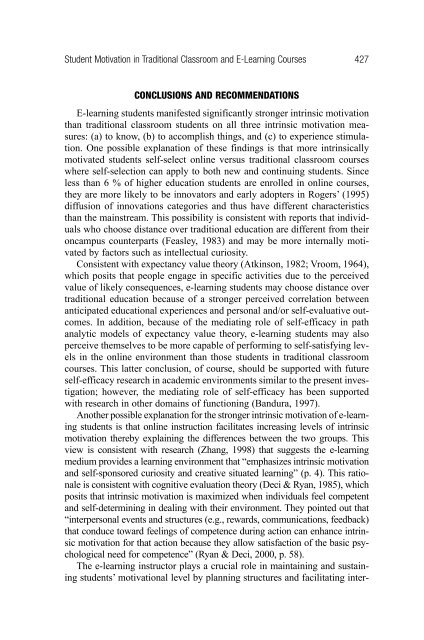A Comparative Analysis of Student Motivation in ... - Anitacrawley.net
A Comparative Analysis of Student Motivation in ... - Anitacrawley.net
A Comparative Analysis of Student Motivation in ... - Anitacrawley.net
You also want an ePaper? Increase the reach of your titles
YUMPU automatically turns print PDFs into web optimized ePapers that Google loves.
<strong>Student</strong> <strong>Motivation</strong> <strong>in</strong> Traditional Classroom and E-Learn<strong>in</strong>g Courses 427CONCLUSIONS AND RECOMMENDATIONSE-learn<strong>in</strong>g students manifested significantly stronger <strong>in</strong>tr<strong>in</strong>sic motivationthan traditional classroom students on all three <strong>in</strong>tr<strong>in</strong>sic motivation measures:(a) to know, (b) to accomplish th<strong>in</strong>gs, and (c) to experience stimulation.One possible explanation <strong>of</strong> these f<strong>in</strong>d<strong>in</strong>gs is that more <strong>in</strong>tr<strong>in</strong>sicallymotivated students self-select onl<strong>in</strong>e versus traditional classroom courseswhere self-selection can apply to both new and cont<strong>in</strong>u<strong>in</strong>g students. S<strong>in</strong>celess than 6 % <strong>of</strong> higher education students are enrolled <strong>in</strong> onl<strong>in</strong>e courses,they are more likely to be <strong>in</strong>novators and early adopters <strong>in</strong> Rogers’ (1995)diffusion <strong>of</strong> <strong>in</strong>novations categories and thus have different characteristicsthan the ma<strong>in</strong>stream. This possibility is consistent with reports that <strong>in</strong>dividualswho choose distance over traditional education are different from theironcampus counterparts (Feasley, 1983) and may be more <strong>in</strong>ternally motivatedby factors such as <strong>in</strong>tellectual curiosity.Consistent with expectancy value theory (Atk<strong>in</strong>son, 1982; Vroom, 1964),which posits that people engage <strong>in</strong> specific activities due to the perceivedvalue <strong>of</strong> likely consequences, e-learn<strong>in</strong>g students may choose distance overtraditional education because <strong>of</strong> a stronger perceived correlation betweenanticipated educational experiences and personal and/or self-evaluative outcomes.In addition, because <strong>of</strong> the mediat<strong>in</strong>g role <strong>of</strong> self-efficacy <strong>in</strong> pathanalytic models <strong>of</strong> expectancy value theory, e-learn<strong>in</strong>g students may alsoperceive themselves to be more capable <strong>of</strong> perform<strong>in</strong>g to self-satisfy<strong>in</strong>g levels<strong>in</strong> the onl<strong>in</strong>e environment than those students <strong>in</strong> traditional classroomcourses. This latter conclusion, <strong>of</strong> course, should be supported with futureself-efficacy research <strong>in</strong> academic environments similar to the present <strong>in</strong>vestigation;however, the mediat<strong>in</strong>g role <strong>of</strong> self-efficacy has been supportedwith research <strong>in</strong> other doma<strong>in</strong>s <strong>of</strong> function<strong>in</strong>g (Bandura, 1997).Another possible explanation for the stronger <strong>in</strong>tr<strong>in</strong>sic motivation <strong>of</strong> e-learn<strong>in</strong>gstudents is that onl<strong>in</strong>e <strong>in</strong>struction facilitates <strong>in</strong>creas<strong>in</strong>g levels <strong>of</strong> <strong>in</strong>tr<strong>in</strong>sicmotivation thereby expla<strong>in</strong><strong>in</strong>g the differences between the two groups. Thisview is consistent with research (Zhang, 1998) that suggests the e-learn<strong>in</strong>gmedium provides a learn<strong>in</strong>g environment that “emphasizes <strong>in</strong>tr<strong>in</strong>sic motivationand self-sponsored curiosity and creative situated learn<strong>in</strong>g” (p. 4). This rationaleis consistent with cognitive evaluation theory (Deci & Ryan, 1985), whichposits that <strong>in</strong>tr<strong>in</strong>sic motivation is maximized when <strong>in</strong>dividuals feel competentand self-determ<strong>in</strong><strong>in</strong>g <strong>in</strong> deal<strong>in</strong>g with their environment. They po<strong>in</strong>ted out that“<strong>in</strong>terpersonal events and structures (e.g., rewards, communications, feedback)that conduce toward feel<strong>in</strong>gs <strong>of</strong> competence dur<strong>in</strong>g action can enhance <strong>in</strong>tr<strong>in</strong>sicmotivation for that action because they allow satisfaction <strong>of</strong> the basic psychologicalneed for competence” (Ryan & Deci, 2000, p. 58).The e-learn<strong>in</strong>g <strong>in</strong>structor plays a crucial role <strong>in</strong> ma<strong>in</strong>ta<strong>in</strong><strong>in</strong>g and susta<strong>in</strong><strong>in</strong>gstudents’ motivational level by plann<strong>in</strong>g structures and facilitat<strong>in</strong>g <strong>in</strong>ter-
















